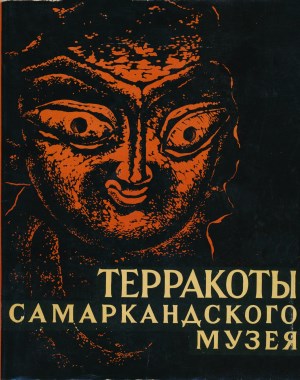 В.А. Мешкерис
В.А. Мешкерис
Терракоты Самаркандского музея.
Каталог древних статуэток и других мелких скульптурных изделий из обожжённой глины, хранящихся в Республиканском Музее истории и культуры и искусства УзССР в городе Самарканде.
// Л.: Изд-во Гос. Эрмитажа. 1962. 140 с.
Содержание
Введение. — 3
Издания с воспроизведением терракот из собрания Самаркандского музея. — 6
Сокращения (литература, места находок, музеи). — 6
Древние художественные терракотовые изделия из Самаркандского музея. — 9 [Структура раздела дублирует структуру Реестра.]
Реестр. — 53
I. Наиболее древние терракоты (до II в. до н.э.) (табл. I, 1-12). — 55
1. Статуэтки переднеазиатского типа (1-4). — 55
2. Статуэтки эллинистического типа (5-12). — 56
II. Статуэтки и налепы кушанского времени (II в. до н.э. — IV в. н.э.). — 57
А. Статуэтки (13-111). — 57
1. Примитивные фигурки (женские и мужские) (13-23). — 57
2. Изображения женского божества (с плодами, трилистником, веткой растения в руках, 24-84). — 59
3. Мужские фигурки (85-90). — 69
4. Музыканты (с флейтами, лютнями, барабанами, 91-107). — 70
5. Разные (108-111). — 73
Б. Налепы (112-114). — 74
III. Терракоты эфталитско-тюркской эпохи (V-VIII вв. н.э.). — 75
A. Статуэтки (115-329). — 75
1. Лепные и лепные с применением штампа (гротески, фигурки со штампованными головками эллинистического и местного типа, отдельные туловища с палицей, музыкальными инструментами в руках, фигурки «в кафтане», отбитые головки (115-301). — 87
2. Воины (всадники) (302-329). — 87
Б. Образки и плитки (330-344). — 92
B. Налепы и штампы (345-363). — 95
Г. Разные художественные изделия (364-370). — 99
IV. Терракоты, трудно поддающиеся определению, и терракоты, происходящие из разных мест (371-410). — 101
Summary. — 108
Таблицы [I-XXX]. — 109
Summary. ^
The collection of ancient terracottas belonging to the Samarkand museum comprises over 700 objects. These are figurines of men and animals, applique ornaments from terracotta vessels, fragments of ossuaries (bone-urns), and vessels in the shape of a human figure, a human head, etc. They are of different date.
The terracottas of the collection mostly come from the Samarkand area (from Aphrasiab — the ruins of the ancient Samarkand, Kafyr-Kala and Tali-Barzu); a few-are derived from the Termez area and from Khorezm. The present collection was started in 1895, when L.S. Barshchevsky donated to the museum a considerable number of art objects in terracotta which were in his possession. The part of the collection contributed by the archaeologist G.V. Grigoryev is of especially great value, for the material is well documented as to the place of manufacture, being all found during the excavations at Tali-Barzu and Kafyr-Kala.
The present volume deals exclusively with terracotta representations of human beings, of which there are more than 400. Among them figurines of the Kushan, the pre-Tiurk and the Tiurk epochs are prevalent. Terracottas of the near eastern and the hellenistic types, dating from the second half of the Ist millenium B.C., though not numerous, are also of great interest.
Most of the figurines of the Kushan epoch have been manufactured in open moulds; terracottas of the pre-Tiurk and Tiurk periods show a combination of techniques, the bodies being formed by hand, and the faces — in moulds. A great number of statuettes are hand-made from beginning to end. Representations of human beings also occur on medallions, on tiles and in applique ornaments on vessels and ossuaries.
The present volume consists of a foreword, an introduction devoted to a description and systematic classification of the Sogd terracottas, a catalogue of terracottas containing their individual characteristics or, less often, descriptions of homogeneous groups, a summary table and 30 plates with photographic representations of over 200 objects. Numbers of the terracottas occurring in the plates are printed in bold type. Figures in the text refer the reader to the numbers of the objects in the catalogue. In every individual description, the inventory number of the object and the maximum height of the terracotta are to be found. References to publications containing reproductions of the Samarkand terracottas, follow the descriptions. References to analogous objects follow the indication of the height, the signature, and the inventory number. Signatures are given for terracottas from other museum collections quoted as analogies; names of the places where the objects come from, are given in abbreviated forms in accordance with the accepted system.
|